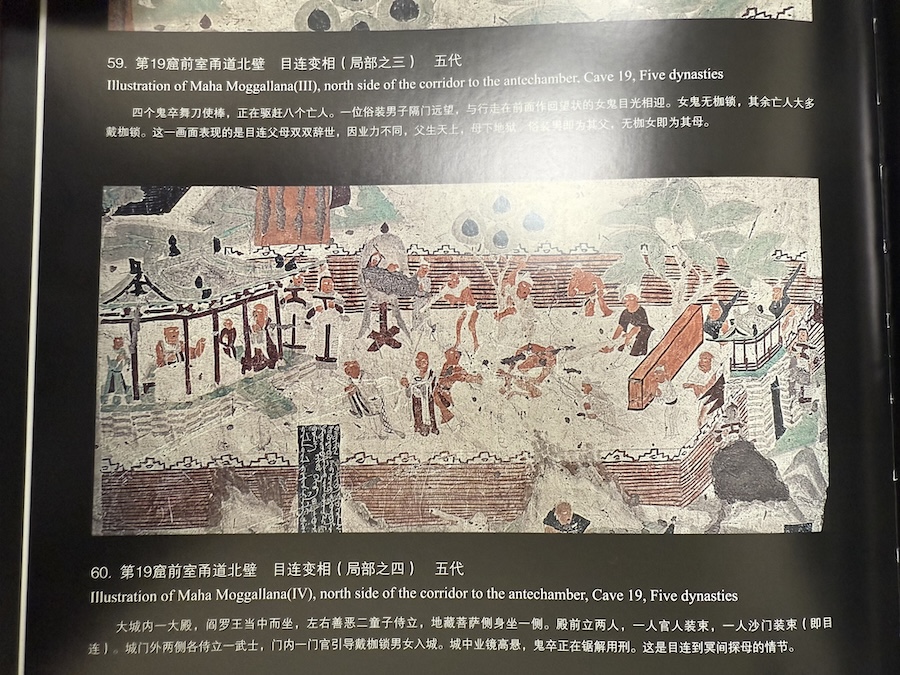A taste of Old Uyghur
« previous post | next post »
It's not every day that you get a chance to experience Old Uyghur (language; script). Recently, when I was looking through albums of photographs of medieval Buddhist wall-paintings, I spotted an Old Uyghur inscription:
(click to embiggen)
That's from a Five Dynasties (907-979) transformation tableau (biànxiàng 變相) depicting the story of the Buddhist saint, Mahāmaudgalyāyana, rescuing his mother from hell. It is located on the north side of the corridor to the antechamber to Cave 19 at Yulin Grottoes toward the western extremity of Gansu Province, part of the larger complex of medieval Buddhist caves at Dunhuang, which we have often mentioned on Language Log. For the complete and heavily annotated translation of the transformation text on Mahāmaudgalyāyana (Mùlián 目連), see Victor H. Mair, Tun-huang Popular Narratives (Cambridge [Cambridgeshire] ; New York: Cambridge University Press, 1983).
Transliteration of the Old Uyghur inscription:
1 yïlan yïl bešinč ay-nïng bir yangï-ta biz sangada(ẓ)?
2 birmäs-ä ikägü kälip bo taγ buqar-ta [ kü]š ̣ i
3 tamdurup alqu ayïγ qïlïnč-larï-mïz a[rïṣu]n tep
4 qopurup xaw sačïp yṳkünüp aq b[alï]q-ta yanïp
5 bardïmïz M tep birmäs-ä biḍyü tägindim
Japanese translation:
①蛇年第五月の初(旬の)一日に。私達サンガダス(?),②
来て,この山寺で‥‥‥香を③燃やして,
に!と言って,④立ち上がり(?)散華(?)して,礼拝して,
行った。と言って,私ビルメセが書き奉った。
English translation:
On a day of the first 10 day period (旬), the fifth month of the Year of the Snake, we two, Sangadas(?) and Birmese, came to this mountain temple, burned incense (③) and prayed for the cleansing of all our misdeeds! Then we rose (④), scattered flowers (?), and bowed before returning to Aqbaliq (⑤). Thus I, Birmese, have written this.
Transliteration and translation from MATSUI Dai and ARAKAWA Shintaro, Multilingual Source Materials of the Dunhuang Grottoes (Tokyo: Tokyo University of Foreign Studies, Research Institute for Languages and Cultures of Asian and Africa, 2017). p. 106.
Some sharp Language Log readers will undoubtedly have noticed this evolution: Aramaic > Old Uyghur > Mongolian, Manchu.
Selected readings
- "Used to be a bun" (7/11/23 — In the comments: Historical novel by the Japanese novelist Yasushi Inoue called 敦煌 (“Tun-Huang,” in the English translation by Jean Oda Moy); Fujieda Akira, Dunhuang mss, history of Dunhuang; Hiroshi Kumamoto, Khotanese and other pre-modern Iranian languages; Nikita Kuzmin, Tangut inscriptions in and around Dunhuang
- "A medieval Dunhuang man" (7/17/23)
- Acquiring literacy in medieval Dunhuang" (2/20/21)
- Victor Mair, "Reflections on the Origins of the Modern Standard Mandarin Place-Name 'Dunhuang' — With an Added Note on the Identity of the Modern Uighur Place-Name 'Turpan'", in Li Zheng, et al., eds., Ji Xianlin Jiaoshou bashi huadan jinian lunwenji (Papers in Honour of Prof. Dr. Ji Xianlin on the Occasion of His 80th Birthday) (Nanchang: Jiangxi People's Press, 1991), vol. 2, pp. 901-954 (very long and detailed study).
- Victor H. Mair, "Lay Students and the Making of Written Vernacular Narrative: An Inventory of Tun-huang Manuscripts", Chinoperl Papers 10 (1981), 5–96.
[Thanks to Hiroshi Kumamoto, Jing Hu]

Rodger C said,
August 4, 2025 @ 9:25 am
I clicked it to embiggen, and it ensmallened.
Philip Taylor said,
August 4, 2025 @ 3:04 pm
It enlarges (sorry, I refuse to use "*embiggen") successfully here in Firefox 140.0.4, 64-bit under Windows 11, Rodger, even with JavaScript disabled (default state for uBlock Origin).